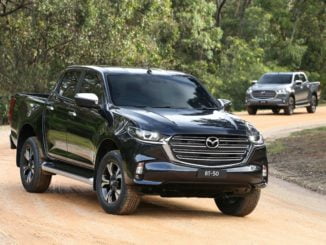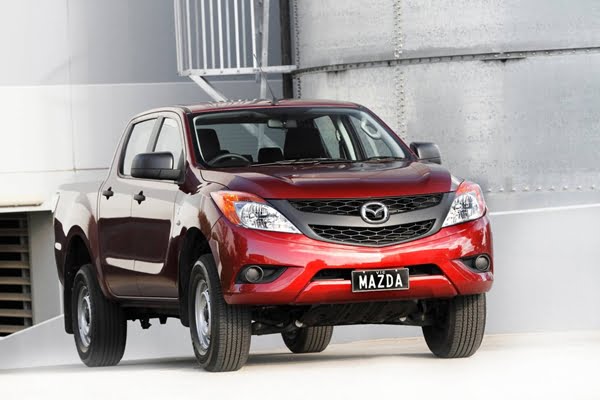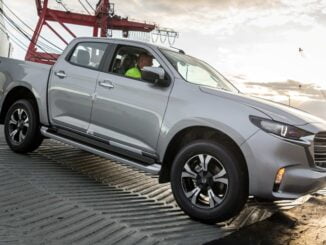SUVs have dominated the talk of car sales figures, but there is another segment in the market that’s doing remarkably well, particularly in Australia, and that is utilities.
So far this year, the overall ute market has increased in sales by over 9.5 percent. In percentage terms that’s nearly as much as the SUV segment, so it’s an important part of the market and it is growing strongly.
Mazda has one model in this segment, the BT-50, which was first released here in 2011 and comes with a choice of three body styles: Single Cab; Freestyle (extended) Cab; and Dual Cab.
The local office felt it was time for a bit of a refresh particularly given that Australia is Mazda’s largest market for the BT-50. So a few people from the local marketing and engineering departments got together and designed a bumper and grille that is, at the moment, unique to our market.
The brochure for the vehicle starts off by saying: “When it comes to utility vehicles, Australians are looking for a ute that rings true to its purpose; a ute that is built tough, works hard and looks strong”.
While this might “ring true” as marketing hype, there is no doubt that a tough image is an important part of the appeal of these vehicles.
But the reality is also that comfort and features are imperatives in a similar way in which the four-wheel-drive market has shifted to SUVs which now include more cozy features.
So while the first thing they tell you about the new BT-50 is the look, some of the features for the occupants are where the good news is, in my opinion.
Exterior
The visual part of Mazda’s “New Look” BT-50, is at the front of the vehicle and it is not startlingly different.
They aimed to lower the visual centre of gravity at the front with a slightly stronger characteristics at, and below, the dumper bar line.
It gives it a slightly lower stance, in line with Mazda’s zoom-zoom image of a low-slung sporty vehicle. They have pushed the front corners forward a bit to give a squarer look and there are some slight changes to the grille and head lights.
The rest of the body and back of the vehicle are still the same although on the outside, the GT now includes as standard: polished alloys, a chrome sports bar, tub liner, remote tailgate locking and a 12V smart auxiliary socket and light in the tub.
 Interior
Interior
The BT-50 maintains a simple but effective interior, with not a lot of controls on the steering wheel and simple and easy to read dials (a tacho and a speedo). There are three model variations: the XT; the XTR; and the GT.
Drive and Engine
There remains two engine options, both diesels and both come with either a 6-speed manual or 6-speed automatic transmission.
The smaller, 2.2 litre four cylinder diesel is only available in the single cab entry level vehicle. It pushes out a modest 110 kW and 375Nm of torque.
The 3.2 litre in-line 5 cylinder diesel engine is available in all the other models and has a 147 kW of power and a more impressive 470 Nm of torque. We only drove dual cab models on the launch.
The 3.2 litre diesel is not class leading with its power figure but it worked very well with the automatic gear box.
Across the rutted, dirt roads of the Gawler Rangers it was remarkably comfortable. It has a leaf spring suspension at the rear and while we have driven an opposition’s coil sprung ute, which is assumed to be better for ride comfort, the Mazda handled the situation very well.
When we got back onto the bitumen of a typical outback highway, the BT-50, like most of the vehicles in this class, showed that it is not in the sedan class. Undulations are felt not aggressively but in a manner that reminds you that you are in a vehicle that is built to be capable in rough conditions. It is not bad, but just not its strong point. That they call the top of the range model the GT is stretching the use of the ‘Grand Touring’ terminology.
Features
All of the BT-50 range has Apple Car Play and Android Auto connectivity. This is a first for Mazda in any model in Australia and probably around the world. This is fast becoming the first feature that people are now looking for.
Some of the features of the base model, single cab BT-50 include:
- 16-inch steel wheels
- Cruise control
- Lockable glovebox
- Reversing camera
- Emergency Stop Signal (ESS)
- Hill Launch Assist (HLA)
- Roll Stability Control (RSC)
- Trailer Sway Control (TSC)
Some of the features you get if you move into the XTR include:
- 17 inch alloys
- 8 inch infotainment screen
- Power mirrors (chrome)
- Rear step bumper (chrome)
- Side steps (tubular, polished)
- Tailgate lock
- Wipers (front) 2-speed with rain-sensing function
Going all the way to the GT includes the tray features mentioned above and:
- Power mirrors (heating and folding
- function) with turn indicator
- Privacy glass
- Front seats with: 8-way power adjustment (driver)
- Black leather Seat Trim
Good bits
- Apple Carplay/Android Auto
- Well-constructed
- Engine matches well with gear box
Not so good bits
- Engine power not class leading especially the small one
- No petrol options
- Rural bitumen ‘highway’ touring is not as comfortable as a typical car or a number of SUVs.
 Summary
Summary
It hasn’t changed a great deal but with its new Aussie ‘nose’ makes it look a little more aggressive; better connectivity makes it more functional; and added features make it more desirable.
The Mazda BT-50 has done relatively better with its two-wheel drive variants but these changes may help push it up the sales ladder in the four-wheel drive models.
Facts and Figures: 2018 Mazda BT-50
- Engine: 3.2L 5-cylinder diesel 147 kW/470 Nm
- Transmission: Six-speed automatic
- Safety: 5-star
- 2 yrs unlimited km or 3 yrs/100,000km (within in the first 2 years).
- Price: from $35,990







